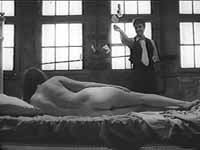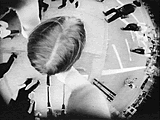
| American Independent Narrative Cinema of the '60s: A Brief Survey (Page Two) | |
|
Some directors combined visual and aural experimentation to breathe life into what they viewed as a moribund art form. Shirley Clarke's The Cool World (1964), for example, contains a brilliant sequence in which Duke, a 14-year-old gang leader, is talking to a young whore, Luanne. Clarke allows just a few sentences of dialogue between them, then dubs a brief segment from Mal Waldron's powerful jazz score over their words, then returns to the conversation, continuing this variation to tremendous surging effect. The color and dynamism of Clarke's rendering of this encounter contrast with the squalid, carefully observed urban backgrounds of New York, circa 1964. | |
|
New York appears as the center of much of the independent movement of this period--Clarke, Cassavetes, Morris Engel, Martin Scorsese, and Rogosin all worked out of New York and found much of their inspiration there. The grinding poverty and racially mixed neighborhoods of the city provide both backdrop and subject for many of the films, which, by portraying the difficulty, even impossibility, of human relations (particularly sexual and romantic), dealt a body blow to the credibility of the "happy ending" in American cinema. Films like the downbeat Weddings and Babies (1958) by Morris Engel simply refused to introduce the reassuring romantic deus ex machina beloved by the majority of mainstream filmmakers. |
 We can cite also the nervous, intense, hand-held camerawork of Martin Scorsese's Who's That Knocking at My Door? (1969) or John Cassavetes' Shadows (1958), films that can be interpreted as behaviorist, formalist, and social realist in equal measure.
We can cite also the nervous, intense, hand-held camerawork of Martin Scorsese's Who's That Knocking at My Door? (1969) or John Cassavetes' Shadows (1958), films that can be interpreted as behaviorist, formalist, and social realist in equal measure.


 Rogosin's Come Back Africa, a powerful examination of apartheid in South Africa, circa 1958, experimented in more ways than the merely formal. He smuggled a camera into South Africa to shoot his film, using native actors and a documentary style that contrasts overwhelming industrial landscapes with grim shots of masses of trapped, oppressed black slave laborers.
Rogosin's Come Back Africa, a powerful examination of apartheid in South Africa, circa 1958, experimented in more ways than the merely formal. He smuggled a camera into South Africa to shoot his film, using native actors and a documentary style that contrasts overwhelming industrial landscapes with grim shots of masses of trapped, oppressed black slave laborers.
 The use of real people and real-time photography in a film like David Holzman's Diary, where the discomfort of the players takes on existential aspects, is apparent in other films of the time and it's especially noteworthy that directors like McBride, William Greaves (Symbiopsychotaxiplasm: Take One, 1967) and Bob Rafelson (Head) could incorporate techniques typical of underground film (Stan Brakhage, Bruce Conner) into their narrative films. This melding of styles creates a hypnotic effect in the viewer, a sense of endless surprise and of forced audience involvement, even complicity, in what is occurring on screen.
The use of real people and real-time photography in a film like David Holzman's Diary, where the discomfort of the players takes on existential aspects, is apparent in other films of the time and it's especially noteworthy that directors like McBride, William Greaves (Symbiopsychotaxiplasm: Take One, 1967) and Bob Rafelson (Head) could incorporate techniques typical of underground film (Stan Brakhage, Bruce Conner) into their narrative films. This melding of styles creates a hypnotic effect in the viewer, a sense of endless surprise and of forced audience involvement, even complicity, in what is occurring on screen.

